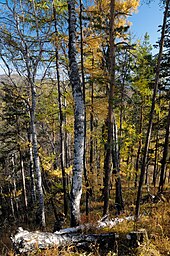Boreal ecosystem

A boreal ecosystem is an ecosystem with a subarctic climate located in the Northern Hemisphere, approximately between 50° and 70°N latitude. These ecosystems are commonly known as taiga and are located in parts of North America, Europe, and Asia.[1] The ecosystems that lie immediately to the south of boreal zones are often called hemiboreal. There are a variety of processes and species that occur in these areas as well.
The Köppen symbols of boreal ecosystems are Dfc, Dwc, Dfd, and Dwd.
Boreal ecosystems are some of the most
Boreal Species

The species within boreal ecosystems varies as it consists of both terrestrial and aquatic habitats. The
However, despite not being as biodiverse as tropical systems, this area has a variety of species. Boreal ecosystems are filled with a multitude of flora species from
Succession
Success and succession happen in tandem in boreal forests. Primary succession, while part of the original landscape formation, is not vital like secondary succession.[10] Secondary succession consists of varied events: wildfires, flooding, mudslides and even excessive insect foraging act in this progression and cycle of boreal forests.[10]
Boreal Ecosystem-Atmosphere Study (BOREAS)
The Boreal Ecosystem-Atmosphere Study (BOREAS) was a major international research field study in the Canadian boreal forest. The main research was completed between the years of 1994-1996, and the program was sponsored by NASA. The primary objectives were to determine how the boreal forest interacts with the atmosphere, how climate change will affect the forest, and how changes in the forest affect weather and climate.[1]
Climate change effects

Boreal ecosystems display high sensitivity towards both natural and
In terms of boreal trees, the poleward limit for any given species is most likely defined by the temperature, whereas the equatorward limit is generally defined by competitive exclusion.[15] As changes in climate occur, change in the corresponding weather variables follows,[15] and ecosystem alterations involving timing for migration, mating, and plant blooming can occur. This can lead to the transition into a different type of ecosystem as the northward shift of plant and animal species has already been observed.[2] Trees may expand towards the tundra; however, they may not survive due to various temperature or precipitation stressors.[16] The rate depends on growth and reproductive rate, and adaptation ability of the vegetation.[16] In addition, the migration of flora may lag behind warming for a few decades to a century, and in most cases warming happens faster than plants can keep up.[2][16]
Due to permafrost thaw and disturbance alterations such as fire and insect outbreaks, certain models have suggested that boreal forests have developed into a net carbon source instead of a net carbon sink.[2] Although the trees in the boreal are aging, they continue to accumulate carbon into their biomass. However, if disturbed, higher than normal amounts of carbon will be lost to the atmosphere.[2]
In some areas, boreal ecosystems are located on a layer of permafrost, which is a layer of permanently frozen soil. The underground
Ecosystem services
In boreal ecosystems,
Forests themselves are producers of lumber products, regulation of water, soil and air quality.[23] Within the past decade, the number of studies focusing on the relationships between ecosystem services has been increasing.[24] This is due to the rise of human management of ecosystems through the manipulation of one ecosystem service to utilize its maximum productivity. Ultimately, this results in the supply decline of other ecosystem services.[24]
See also
- Taiga
- Subarctic climate, also known as "boreal climate"
- Boreal forest of Canada
References
- ^ a b "Introduction to BOREAS, the Boreal Ecosystem-Atmosphere Study". NASA Earth Observatory. NASA. 1999-12-06. Retrieved 13 March 2013.
- ^ a b c d e Olsson, Roger (November 2009). "Boreal Forest and Climate Change" (PDF). Air Pollution & Climate Secretariat.
- ^ Box, Olivia (2021-08-09). "Climate Change's Dangerous Effects on the Boreal Forest". JSTOR Daily. Retrieved 2023-08-02.
- ^ PMID 30839691.
- S2CID 233681227.
- ISSN 1181-8700.
- S2CID 216323804.
- ISSN 1467-2960.
- ISSN 1923-1245.
- ^ )
- ^ Chapin, F. S., et al. 2004. Resilience and vulnerability of northern regions to social and environmental change. Ambio 33:344-349.
- ^ MacDonald, G M., T. W. D. Edwards, K. A. Moser, R. Pienitz, and J. P. Smol. 1993. Rapid response of treeline vegetation and lakes to past climate warming. Nature 361: 243-246.
- ^
- ^ a b Woodward, F.I. 1987. Climate and plant distribution. Cambridge University Press, Cambridge, UK. 188 pp.
- ^ a b c d Bonan, G. B. (2008). Forests and Climate Change: Forcings, Feedbacks, and the Climate Benefits of Forests. Science 320: 1444–1449.
- ^ Ashton, M. S., M. L. Tyrrell, D. Spalding, and B. Gentry. (2012). Managing Forest Carbon in a Changing Climate. New York: Springer.
- ^ IPCC (Intergovernmental Panel on Climate Change). 2001. Chapter 1: Global perspectives. In: R.T. Watson, I.R. Nobel, B. Bolin, N.H. Ravindranath, D.J. Verardo, and D.J. Dokken. Eds. Land use, land-use change and forestry. Cambridge: Cambridge University Press. 550 p.
- doi:10.5589/m13-007
- .
- ^ Pohjanmies, T., Triviño, M., Le Tortorec, E. et al. Ambio (2017) 46: 743. https://doi.org/10.1007/s13280-017-0919-5
- ^ .
